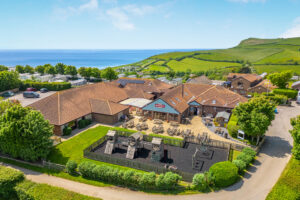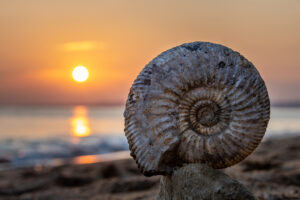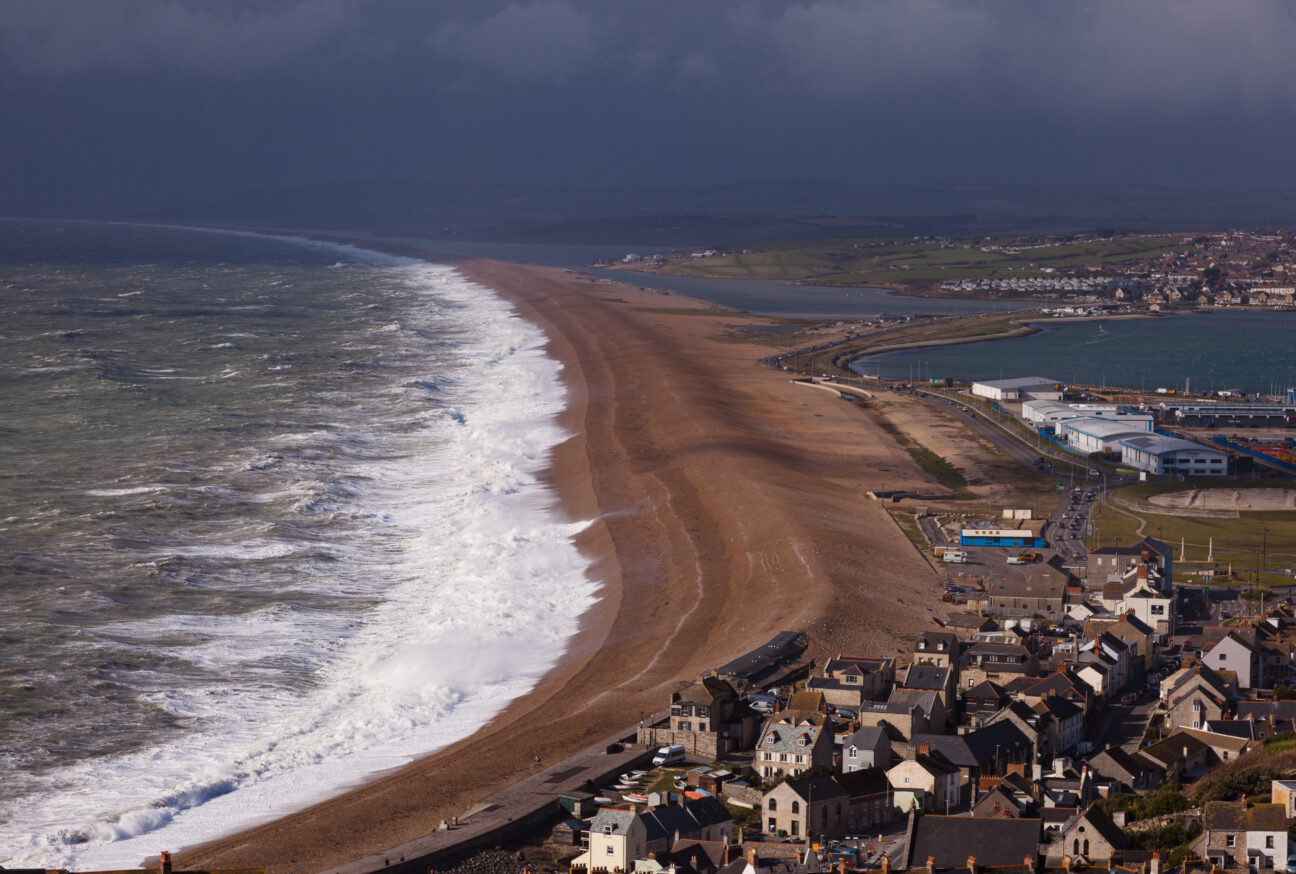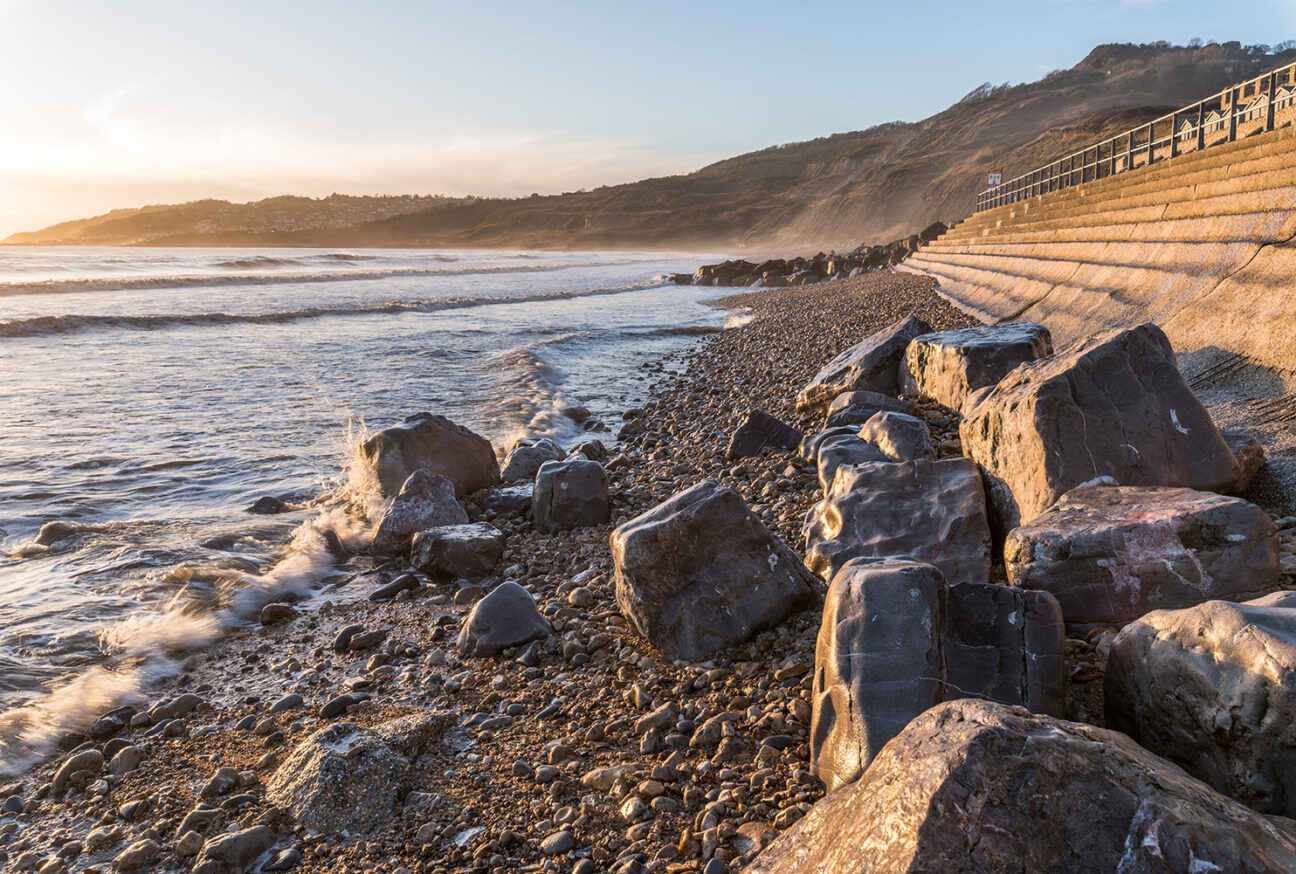Unique Coastal Landforms in Dorset
The county of Dorset sits on the Jurassic Coast World Heritage Site, a breathtaking stretch of coastline known for its unique geological significance. The varying rock structures in this part of the world not only allow for excellent preservation of a wide range of fossils, but also the formation of an incredible array of landforms, many of which attract tourists and photographers from worldwide. In this blog post, we’ll take you on a tour of some of the unique coastal landforms in Dorset, starting from East to West.
Hengistbury Head, Christchurch
Hengistbury Head is a headland that juts out into the English Channel, and is the site of Bronze and Iron Age settlements, the remains of which can be seen today.
Mudeford Spit stretches out from the end of the mainland, formed by the process of longshore drift as sediment gradually moves along the coastline, guarding the entrance to Christchurch Harbour and the Site of Special Scientific Interest there. The spit is also home to some of the UK’s most expensive beach huts.
Poole Harbour
Europe’s largest natural harbour, Poole Harbour provides shelter not just for the thousands of migrating birds that nest there, but also to some of the UK’s keenest watersports enthusiasts. The area is classed as a Ria, meaning that it was once a valley that flooded and “drowned” at the end of the last ice age.
It is now sheltered by the headland of Studland and the spit of Sandbanks, where some of the most expensive properties in the UK can be found. The harbour covers an area of approximately 14 square miles and contains a number of islands, the largest of which is Brownsea Island, known to be the birthplace of the Scouting Movement and the site of a 2000 year old Iron Age longboat wreckage that was discovered in 1964.
Old Harry Rocks, Studland
Old Harry Rocks marks the most Eastern point of the Jurassic Coast and consists of a series of chalk stacks, stumps and small arches and headlands that jut out from the mainland. The chalk here was part of a long stretch that went from the Purbecks to the Isle of Wight, so the famous Needles there were once joined to the formations at Studland.
Stacks like these are formed when arches, like the famous one at Durdle Door, are eroded so much that their roof collapses. When the stacks begin eroding down below the height of the mainland, they become known as stumps. The large stack furthest out to sea here is known as Old Harry, and the stump next to it is known as Old Harry’s Wife.
Technically she’s his second wife, as the original stack collapsed in 1509. The rocks are a great landmark to visit from nearby Studland, either by walking along the South West Coast Path, or by paddling on a kayak or stand up paddle board.
Dancing Ledge, Purbeck
Dancing Ledge is a wave cut platform in the Isle of Purbeck that is a popular location for climbing and coasteering. It’s difficult to access and involves a steep walk and a bit of scrambling to get to from the nearest car park.
The ledge has numerous undulations and dimples, which at certain tide levels, makes the water appear to dance – hence the name. At the start of the twentieth century, a small area of rock was blasted to create a small swimming pool in the ledge to be used by local schools, as the sea itself here is unsafe for swimming.
Chapman’s Pool, Purbeck
Often mistaken for its larger and more famous counterpart, Lulworth Cove, Chapman’s Pool is a small cove that boasts sparkling blue waters and a sheltered place for small boats to moor up.
Because it is harder to get to, you’ll find this cove much quieter than Lulworth, which can get busy during the Summer. The rocks that form the cove are also rich in fossils.
Kimmeridge Bay
One of the best locations for fossil hunting and rockpooling in this part of Dorset, Kimmeridge Bay is consists of a series of clay ledges stretching out to sea.
Be sure to visit the nearby Etches Collection to see some of the fossils collected here over the years. Occasionally, conditions are right to allow surfing on this part of the coast.
Gad Cliff, Tyneham
Gad Cliff, also known as Tyneham Cap, is a cliff face near to the abandoned village of Tyneham, that can only be accessed when the Lulworth Ranges are open to the public.
The cliff is visually very interesting, and clearly shows different layers and ages of rocks that have been affected by sedimentary folding, a process caused by tectonic plate movements. The layers, which would have formed flat, were distorted and warped by plate movements around 30 million years ago.
Lulworth Cove
One of the most famous coastal landforms in Dorset is undoubtedly Lulworth Cove, a beautiful sheltered cove that draws tourists from all over the country. Coves form when bands of different rock types run parallel to the shore.
Once the waves break through the outer, more resistant layer, the softer rocks behind are more easily eroded. The waves bend through the narrow gap, creating the beautiful round cove shape that can be seen here. Lulworth Cove is known as one of the best examples of this kind of landform in the world.
Stair Hole, Lulworth
Just next door to Lulworth Cove is Stair Hole, a small cove that suggests what Lulworth may have looked like early in its formation a few hundred thousand years ago. In a few more thousand years, it may erode into a cove similar to Lulworth, however as the two are so close it’s likely that they will eventually merge together.
The folded layers of limestone rock that make up the coastline are particularly visible here, and are an excellent example of tectonic folding. You can see the S shaped curve where the rocks have been crushed and warped together by plate movements.
Man O’ War Bay
Man O’ War Bay is a cove that is partially enclosed by a series of rocky outcrops that are made of the same Portland Limestone that runs along the coastline and forms the entrance of Lulworth Cove and the arch at neighbouring Durdle Door.
Durdle Door
Durdle Door is another of the more iconic coastal landforms in Dorset, and in fact is one of the most famous in the UK, if not the world. The archway is located just the other side of the headland from Man O’ War Bay and is formed of the same Portland Limestone that is particularly resistant to erosion. There are a couple of smaller rocky outcrops just along from the archway, similar to those at Man O’ War Bay. In 2021, a similarly famous arch, Darwin’s Arch in the Galapagos Islands, collapsed due to natural erosion, leaving two stacks where the arch once stood. This is sadly the fate that one day awaits Durdle Door, though thankfully we’re unlikely to see this in our lifetime. Durdle Door draws tourists from around the world, and on a warm Summer’s day the beach and surrounding paths can be incredibly busy.
Bat’s Head and Butter Rock
The other end of the bay from Durdle Door is Bat’s Head, a small chalk headland that contains a cave and a very small arch known as Bat’s Hole.
It’s possible to walk through the arch at low tide. Just in front of the headland is a small stump called Butter Rock. The headland is a popular place to take photographs of Durdle Door.
The Isle of Portland
Portland is often referred to as an island, and whilst this will have been the case at one stage hundreds of thousands of years ago, it is now technically a “tied island”. This means that it has since been joined to the mainland by a tombolo, a type of spit that has grown to connect land at both ends. As you might expect, the rocks that make up Portland are incredibly erosion-resistant, and Portland stone has been used to make some of the most famous buildings in the country including St Paul’s Cathedral, The Tower of London and parts of Buckingham Palace. The start of The Isle of Portland marks the end of Chesil Beach. Portland Harbour is one of the largest man-made harbours in the world, having played a vital part during World Wars 1 and 2, and hosting the sailing events of the 2012 Olympics.
Chesil Beach and The Fleet Lagoon
Chesil Beach is an 18 mile shingle beach that runs from West Bay to the Isle of Portland. Because of the length of the beach, the size and material of the shingle varies considerably along its length.
Behind part of the length of the beach is The Fleet, a tidal lagoon home to a huge range of wildlife and a wide range of designations to protect the marine and avian life that lives and migrates there. The Fleet, which is England’s largest lagoon, runs for just over 8 miles, between Abbotsbury and Portland.
East Cliff, West Bay
The iconic golden cliffs at West Bay played a starring role in ITV’s murder mystery drama Broadchurch, leading to an increase in tourist interest in the area. The cliffs provide a stunning backdrop for people taking photos on the piers at the entrance to the fishing harbour. Erosion has lead to bands of harder rock in the cliffs becoming more pronounced, while the softer rock layers are eaten away, resulting in a striped appearance on the cliff face.
After rock falls, which happen incredibly frequently along this part of the coast, these bands are noticeably smoother until the sea air has chance to erode the softer layers again. Because of the frequency of rock falls in the area, we do not recommend walking or sitting under the cliffs here, or close to the edge along the top.
Golden Cap, Seatown
Golden Cap is the highest point on the South Coast of England, standing at 191m above sea level. It’s also the namesake of our Golden Cap Holiday Park, which sits at the base of the peak, and just behind the beach at Seatown.
The name comes from an outcrop of golden coloured greensand rock at the very top of the cliff.
The Spittles and Black Ven
Situated between two of the best fossil hunting beaches in the country, Charmouth and Lyme Regis, these cliffs are filled with history! The clay cliffs here suffer from some of the largest mudslides in Europe, which constantly brings new fossils to the base of the cliff to be discovered, though larger fossils are often damaged in the process.
Mary Anning famously found an Icthyosaurus here and James Harrison found the first fossilised remains of a Scelidosaurus.
Monmouth Beach Ammonite Pavement
The other side of Lyme Regis to The Spittles is Monmouth Beach. The western end contains thousands of ammonites, many up to 70cm in diameter, and has become known as The Ammonite Pavement.
The ammonites here are embedded into the limestone rock and are only exposed at low tide. As they spend so much of their time underwater, and the remaining time being walked over by visitors, they are fairly worn away and have a softened appearance as a result, but they’re spectacular to see nonetheless.
Wow! What an incredible list of famous and not-so-famous coastal landforms in Dorset. As a county, we really are spoilt for choice when it comes to beautiful and environmentally and historically significant places to visit.
West Dorset Leisure Holidays
West Dorset Leisure Holidays are a group of family run holiday parks on or near to the Jurassic Coast in Dorset. Each park is unique and offers a different range of accommodation and facilities. We offer holidays in lodges, caravans and glamping pods as well as pitches for touring & camping. We also have caravan and lodge holiday homes for sale across all of our parks.
Our award-winning facilities include Martin’s Bar & Restaurant, Highlands End Leisure Club, the Little Fire Station Soft Play and Dorset Foot Golf. The parks are all family friendly, dog friendly and are situated in beautiful locations in the Dorset coast and countryside. You’ll find a great range of places to visit and things to do nearby, whichever park you choose. Check availability and make a booking for a holiday today, or contact our bookings team by emailing bookings@wdlh.co.uk
Published
Share:






















































































































































